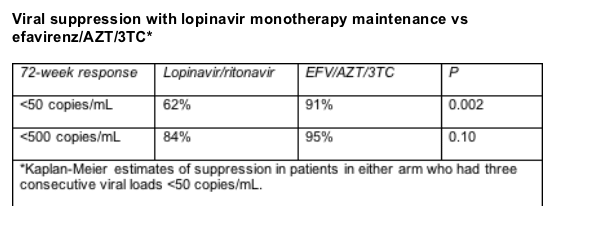 |
 |
 |
| |
Risks With Lopinavir "Monotherapy" After 3-Drug Suppression
|
| |
| |
XVI International AIDS Conference, Toronto
Mark Mascolini
August 17, 2006
Two randomized trials of lopinavir/ritonavir "monotherapy" as a maintenance regimen after viral suppression with lopinavir/ritonavir plus two nucleosides suggested the strategy may be effective for certain people, but not without risk [1,2]. In the first of these trials presented at the International AIDS Conference, viral suppression with lopinavir/ritonavir maintenance was not as tight as suppression with efavirenz plus two nucleosides [1]. Both trials demonstrated a small but nonnegligible risk of resistance with solo lopinavir/ritonavir.
The first study involved 155 antiretroviral-naive people, 104 of them randomized to take lopinavir/ritonavir plus AZT/3TC for at least 24 weeks and 51 to begin efavirenz plus AZT/3TC [1]. People in the lopinavir/ritonavir group who kept their viral load below 50 copies/mL for 3 consecutive months could stop AZT/3TC, whereas everyone in the efavirenz arm continued all three drugs.
Seventy-nine people (76%) in the lopinavir group--71 of them (68%) on monotherapy--completed the 96-week study, compared with 34 (67%) in the efavirenz group. Toxicity-related dropout rates were similar in the two groups--3% with lopinavir/ritonavir and 2% with efavirenz.
In an intent-to-treat analysis, 50% of those randomized to lopinavir achieved and maintained a viral load below 50 copies/mL compared with 61% taking efavirenz, but that difference lacked statistical significance (P = 0.23). Kaplan-Meier analysis of patients maintaining a viral load below 50 copies/mL did find a significant difference favoring efavirenz-based triple therapy (Table).

Eleven of 12 patients who had a rebound to 50-500 copies/mL regained a sub-50-copy reading without resuming AZT/3TC, while 2 of 4 people who did restart AZT/3TC failed to get their viral load back under 50 copies/mL.
Two of 15 people tested for resistance during a lopinavir monotherapy rebound had new protease inhibitor (PI) mutations. One of 5 people tested for resistance in the efavirenz arm had nonnucleoside-related mutations. The 3TC-related M184V mutation emerged in two of 15 lopinavir failure samples (13%) and in one of five efavirenz failure samples (20%).
Jose Arribas (Hospital La Paz, Madrid) and clinicians at other Spanish hospitals randomized 100 people to lopinavir/ritonavir monotherapy maintenance and 98 to continue two nucleosides with lopinavir/ritonavir [2]. To qualify for the study, people needed a viral load below 50 copies/mL for more than 6 months with lopinavir/ritonavir plus two nucleosides and no record of a virologic failure with a PI.
The Spanish team defined therapeutic failure as not returning for study visits, stopping treatment, changing treatment (except for restarting nucleosides in the monotherapy group), or a confirmed viral load above 500 copies/mL (except for monotherapy patients who got back below 50 copies/mL without restarting nucleosides). To put it succinctly, in the monotherapy group restarting nucleosides or having a transient rebound above 50 copies/mL did not count as failure in the primary analysis.
After 48 weeks of follow-up, 94% in the monotherapy group and 90% in the triple-therapy group did not have therapeutic failure. In an intent-to-treat analysis in which missing data or restarting nucleosides did count as failure, 85% on monotherapy and 90% on triple therapy had a 48-week viral load below 50 copies/mL, a nonsignificant difference (P = 0.4). In the same kind of intent-to-treat analysis, 89% on monotherapy and 90% on triple therapy had a 48-week viral load below 500 copies/mL (P = 0.99).
The six confirmed failures in the monotherapy group occurred in 1 person who changed therapy, 2 people with confirmed rebounds and PI resistance, and 3 people who stopped coming in for checkups. Although primary PI mutations emerged in only 2 people taking lopinavir/ritonavir monotherapy, those results rely on standard sequencing that may miss small populations of mutants.
Based on these findings, Arribas proposed that about 85% of people like those who qualified for this trial do not need nucleosides to maintain viral suppression, about 10% lose viral control because of episodic poor adherence, and about 5% have persistent low-level viremia without clear evidence of poor adherence. Predicting shaky adherence is not easy; predicting low-level viremia with good adherence is probably impossible.
Neither Cameron nor Arribas reported seminal or cerebrospinal penetration with lopinavir/ritonavir monotherapy.
References
1. Cameron W, da Silva B, Arribas J, et al. A two-year randomized controlled clinical trial in antiretroviral-naive subjects using lopinavir/ritonavir (LPV/r) monotherapy after initial induction treatment compared to an efavirenz (EFV) 3-drug regimen (Study M03-613). XVI International AIDS Conference. August 13-18. Toronto. Abstract THLB0201.
2. Arribas J, Pulido F, Delgado R, et al. Lopinavir/ritonavir as single-drug maintenance therapy in patients with HIV- viral suppression: forty eight week results of a randomized, controlled, open label, clinical trial (OK04 study). XVI International AIDS Conference. August 13-18. Toronto. Abstract THLB0203.
|
| |
|
 |
 |
|
|